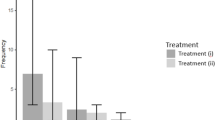Summary
Two physiological races of the carabid beetle, Pterostichus nigrita, are compared. The larvae from the northern Scandinavian population (polar circle) develop faster in all temperature regimens, have a reduced mortality in lower temperatures and an increased growth rate in high temperatures compared with the central European beetles (Cologne). Thus they are able to survive sudden cold spells and during optimal temperatures can compensate for periods of reduced development.
In females sexual maturity is induced by short-day photoperiods followed by long-day photoperiods (previtellogenesis and vitellogenesis, respectively). Males can mature in short-days alone (formation of spermatozeugma). All short-day dependent processes of the subarctic beetles are still possible in far longer photoperiods. The critical day-length, however, for vitellogenesis is only slightly changed.
The ecological significance of these physiological adaptations is discussed.
Zusammenfassung
Zwei physiologische Rassen des Laufkäfers Pterostichus nigrita wurden verglichen. Die Larven einer nordskandinavischen Population (Polarkreis) hatten im Vergleich zu mitteleuropäischen Exemplaren (Köln) bei allen Versuchstemperaturen eine kürzere Entwicklungsdauer, eine geringere Mortalität bei niedrigen Temperaturen und eine gesteigerte Wachstumsgeschwindigkeit bei hohen Temperaturen. Dadurch wird ein erfolgreiches Überdauern von Kälteperioden und ein Aufholen von Entwicklungsrückständen während optimaler Temperaturen im kurzen subarktischen Sommer ermöglicht.
Die Sexualreife wurde bei den Weibchen durch die Aufeinanderfolge von Kurztag (Prävitellogenese) und Langtag (Vitellogenese) herbeigeführt. Bei den Männchen genügte die Einwirkung von Kurztag (Spermatozeugmenbildung). Alle kurztagabhängigen Prozesse waren bei den nordskandinavischen Käfern noch bei erheblich längeren Photoperioden möglich. Die kritische Photoperiode für die Vitellogenese war dagegen nur geringfügig verändert.
Die ökologische Bedeutung dieser physiologischen Adaptationen wird diskutiert.
Similar content being viewed by others
Literatur
Beck, S. D.: Photoperiodism and ecological adaptation. In: Insect photoperiodism, p. 209–239. New York-London: Academic Press 1968
Blunck, H.: Die Entwicklung des Dysticus marginalis L. vom Ei bis zur Imago. 2. Teil. Z. wiss. Zool. 121, 171–391 (1924)
Bondarenko, N. V., Khai-Yuan, K.: The characteristics of the onset of diapause in different geographical populations of the spider mite. Rep. Acad. Sci. USSR 119 (6), 1247–1250 (1958)
Danilevskij, A. S.: Photoperiodism and seasonal development of insects. Edinburgh-London: Oliver and Boyd 1965
Danilevskij, A. S., Goryshin, N. I., Tyshchenko, V. P.: Biological rhythms in terrestrial arthropods. Ann. Rev. Entomol. 15, 201–244 (1970)
Downes, J. A.: What is an arctic insect? Canad. Ent. 94, 143–162 (1962)
Downes, J. A.: Arctic insects and their environment. Canad. Ent. 96, 279–307 (1964)
Downes, J. A.: Adaptions of insects in the arctic. Ann. Rev. Entomol. 10, 257–274 (1965)
Ferenz, H.-J.: Steuerung der Larval- und Imaginalentwicklung von Pterostichus nigrita F. (Col., Carabidae) durch Umweltfaktoren und Hormone. Dissertation, Köln (1973)
Ferenz, H.-J.: Photoperiodic and hormonal control of reproduction in male beetles, Pterostichus nigrita. J. Insect Physiol. 21, (1975, in Druck)
Gersdorff, E.: Ökologisch-faunistische Untersuchungen über die Carabiden der mecklenburgischen Landschaft. Zool. Jb. (Syst.) 70, 17–86 (1937)
Hoffmann, H. J.: Neuroendocrine control of diapause and oocyte maturation in the beetle, Pterostichus nigrita. J. Insect. Physiol. 16, 629–642 (1970)
Krogerus, R.: Ökologische Studien über nordische Moorarthropoden. Soc. Sci. Fenn., Comm. Biol. XXI, 3, 8–238 (1960)
Krumbiegel, J.: Untersuchungen über physiologische Rassenbildung. Zool. Jb. (Syst.) 63, 183–274 (1932)
Schmidt, G.: Zum Problem der physiologischen Rassenbildung. Zool. Anz. 137, 14–19 (1956)
Thiele, H. U.: Formen der Diapausesteuerung bei Carabiden. Zool. Anz., Suppl. 31, (Verh. Dtsch. Zool. Ges. 1967), 358–364 (1968)
Thiele, H. U.: Die Steuerung der Jahresrhythmik von Carabiden durch exogene und endogene Faktoren. Zool. Jb. (Syst.) 98, 341–371 (1971)
Wilde, J. de: Photoperiodism in insects and mites. Ann. Rev. Entomol. 7, 1–26 (1962)
Author information
Authors and Affiliations
Additional information
Mit Unterstützung der Deutschen Forschungsgemeinschaft.
Rights and permissions
About this article
Cite this article
Ferenz, HJ. Anpassungen von Pterostichus nigrita F. (Col., Carab.) an subarktische Bedingungen. Oecologia 19, 49–57 (1975). https://doi.org/10.1007/BF00377589
Received:
Issue Date:
DOI: https://doi.org/10.1007/BF00377589




